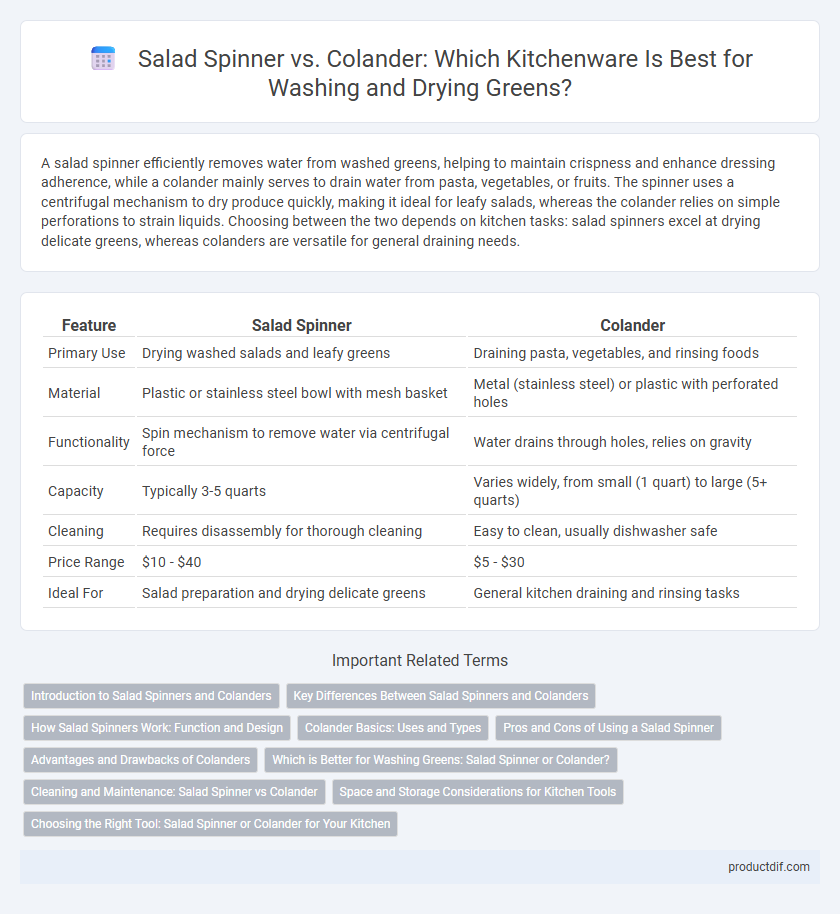A salad spinner efficiently removes water from washed greens, helping to maintain crispness and enhance dressing adherence, while a colander mainly serves to drain water from pasta, vegetables, or fruits. The spinner uses a centrifugal mechanism to dry produce quickly, making it ideal for leafy salads, whereas the colander relies on simple perforations to strain liquids. Choosing between the two depends on kitchen tasks: salad spinners excel at drying delicate greens, whereas colanders are versatile for general draining needs.
Table of Comparison
| Feature | Salad Spinner | Colander |
|---|---|---|
| Primary Use | Drying washed salads and leafy greens | Draining pasta, vegetables, and rinsing foods |
| Material | Plastic or stainless steel bowl with mesh basket | Metal (stainless steel) or plastic with perforated holes |
| Functionality | Spin mechanism to remove water via centrifugal force | Water drains through holes, relies on gravity |
| Capacity | Typically 3-5 quarts | Varies widely, from small (1 quart) to large (5+ quarts) |
| Cleaning | Requires disassembly for thorough cleaning | Easy to clean, usually dishwasher safe |
| Price Range | $10 - $40 | $5 - $30 |
| Ideal For | Salad preparation and drying delicate greens | General kitchen draining and rinsing tasks |
Introduction to Salad Spinners and Colanders
Salad spinners efficiently remove water from washed greens using a spinning basket and centrifugal force, ensuring crisp, dry leaves for salads. Colanders are perforated bowls designed to drain water from pasta, vegetables, and fruits by allowing liquid to pass through their holes. Both kitchenware tools enhance food preparation but serve distinct purposes: salad spinners focus on drying leafy produce while colanders assist in draining various ingredients.
Key Differences Between Salad Spinners and Colanders
Salad spinners use a centrifugal mechanism to rapidly remove water from washed greens, preserving freshness and preventing sogginess, while colanders are simple perforated bowls designed for draining liquids from various foods like pasta or vegetables. Salad spinners typically have a tight-fitting lid and rotating basket, enabling efficient drying of delicate leafy vegetables, whereas colanders lack moving parts and rely solely on gravity for drainage. The choice depends on whether the focus is on drying salad ingredients or draining heavier foods, impacting kitchen efficiency and food texture.
How Salad Spinners Work: Function and Design
Salad spinners operate using a centrifugal force mechanism, where a rotating basket inside the outer bowl rapidly spins to remove water from washed greens, enhancing drying efficiency compared to traditional colanders. Their design typically features a manual or pump-activated spinner with perforated baskets that allow water to escape while keeping the salad contained. This functional advantage preserves leaf texture and reduces excess moisture, preventing soggy salads and improving dressing adhesion.
Colander Basics: Uses and Types
A colander is a kitchen essential designed for draining liquids from foods like pasta, vegetables, and fruits, featuring perforated sides or bottoms to allow water to escape quickly. Common types include stainless steel colanders for durability, plastic colanders for lightweight use, and collapsible silicone colanders ideal for compact storage. Understanding these basic uses and varieties helps optimize food preparation efficiency and kitchen organization.
Pros and Cons of Using a Salad Spinner
A salad spinner efficiently removes excess water from leafy greens, enhancing salad texture and dressing adherence while minimizing spoilage. It offers large capacity and quick drying, but requires storage space and can be more expensive than a colander. Unlike the simple colander, a salad spinner's rotating mechanism may need cleaning and occasional maintenance.
Advantages and Drawbacks of Colanders
Colanders offer efficient water drainage with large perforations that prevent food from slipping through, making them ideal for rinsing vegetables and draining pasta. Their lightweight design and durability often result in easy handling and long-lasting use, while some models feature feet or handles for stability. However, colanders can be less effective for drying leafy greens compared to salad spinners, and water tends to remain on food due to less effective spinning or shaking capabilities.
Which is Better for Washing Greens: Salad Spinner or Colander?
A salad spinner is more efficient for washing greens because its rotating mechanism quickly removes water, preventing soggy leaves and preserving freshness. In contrast, a colander rinses greens thoroughly but does not effectively remove excess water, often requiring additional drying. For crisp, dry salad greens, the salad spinner provides superior performance compared to a colander.
Cleaning and Maintenance: Salad Spinner vs Colander
A salad spinner features removable baskets and tight-sealing lids, allowing for easy disassembly and thorough cleaning compared to a colander's simple, open design. Plastic and stainless steel materials in salad spinners resist staining and odors, enhancing durability during maintenance, whereas colanders, depending on the material, may require more frequent scrubbing to prevent food residue buildup. Regular cleaning of both tools with warm, soapy water prevents bacterial growth, but salad spinners often dry faster due to efficient water removal during spinning.
Space and Storage Considerations for Kitchen Tools
Salad spinners often occupy more vertical space due to their integrated bowl and spinning mechanism, making them less compact than traditional colanders. Colanders typically stack easily within other bowls, optimizing storage in limited kitchen cabinets or drawers. Choosing between the two depends on available storage space and whether multifunctional design or compactness is prioritized.
Choosing the Right Tool: Salad Spinner or Colander for Your Kitchen
Selecting the right tool between a salad spinner and a colander depends on your kitchen needs and food preparation habits. A salad spinner excels at efficiently drying leafy greens and herbs, preserving freshness and texture with its centrifugal spinning mechanism. A colander offers versatile draining options for pasta, vegetables, and rinsing produce but lacks the drying efficiency of a salad spinner, making it ideal for general kitchen tasks.
Salad Spinner vs Colander Infographic

 productdif.com
productdif.com